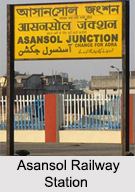 Asansol is a culturally and ethnically diverse place in Paschim Bardhaman District of West Bengal. Asansol is a city developed by the many industries of both secondary and tertiary sectors.
Asansol is a culturally and ethnically diverse place in Paschim Bardhaman District of West Bengal. Asansol is a city developed by the many industries of both secondary and tertiary sectors.
Naming of Asansol
Asansol is derived from the "Asan" a species of tree which generally grows in Asansol. This type of tree is grown generally on the banks of Damodar River, while the "Sol" is noted as the land.
History of Asansol
Asansol in the early age was the land of Dravidian races and the Austroloids races. It was around 2500 years ago, Asansol became the centre for Jainism. Lord Mahavira Vardhamana, the last Tirthankar of Jain religion worked here for some time. In later years the area became part of Bishnupur Kingdom of Malla Tribe. Asansol witnessed the rule of different kingdoms like Malla and Maratha Empire.
Geography of Asansol
 Asansol is located in between the two mighty rivers, the Damodar River and Ajay River. Asansol is located on the lower Chota Nagpur Plateau. A small rivulet, Nunia River, flows past Asansol.
Asansol is located in between the two mighty rivers, the Damodar River and Ajay River. Asansol is located on the lower Chota Nagpur Plateau. A small rivulet, Nunia River, flows past Asansol.
Climate of Asansol
Asansol enjoys summer, winters, autumn, spring and monsoon. Asansol experiences a hot and humid climate in summers and rainy season, while the winters are very cold and dry.
Demography of Asansol
According to the Population Census in the year 2011, Asnasol has 564,491 people; of which male and female are 293,748 and 270,743 respectively. Although Asansol has population of 564,491; its urban-metropolitan population is 1,243,008 of which 647,831 are males and 595,177 are females.
Education of Asansol
In education section, the total literates in Asansol city are 431,300 of which 236,683 are males while 194,617 are females. The average literacy rate of Asansol city is 84.82 percent of which male and female literacy was 89.52 and 79.73 percent. There are a number of colleges and schools in Asansol that provide quality education. There are four colleges, an engineering college, one medical college and two polytechnics centre at Asansol.
Administration of Asansol
 Asansol is administered by Asansol Municipal Corporation. Asansol-Durgapur Development Authority (ADDA) was established to develop the urban areas of Asansol.
Asansol is administered by Asansol Municipal Corporation. Asansol-Durgapur Development Authority (ADDA) was established to develop the urban areas of Asansol.
Economy of Asansol
There are a number of coal and steel industries at Asansol. Indian Iron and Steel Company Ltd, Eastern Coalfields, Chittaranjan Locomotive Works at Chittaranjan, Dishergarh Power Supply, Damodar Valley Corporation and many others are the popular industries in Asansol.
Culture of Asansol
Culture of Asansol is associated with urban life and sports of both West Bengal and Jharkhand. The people of Jharkhand, Bihar and Kolkata used to reside there.
Tourism in Asansol
Sacred Heart Church, Kalyaneshwari Temple, Ghagar Buri Chandi Temple, Begunia, Baba Chandrachur Temple, Jagannath Temple, Town Puja Complex, Saint Anthony`s Church, Burnpur Nehru Park, Indian National Army Memorial, Maithon Dam, Panorama Resort and Water Park are the prominent tourism destinations in Asansol.
Visiting Information
Asansol is connected with all the popular cities of India with roadways, railways and airways. This modern metropolitan city is linked with Andal, Raniganj, Kolkata and Durgapur. Kazi Nazrul Islam Airport is the nearest domestic airport.



















